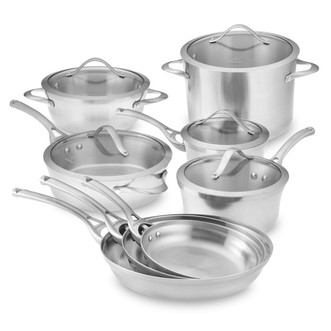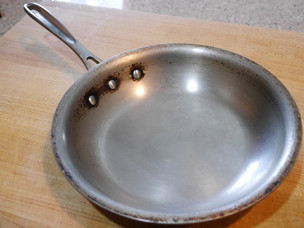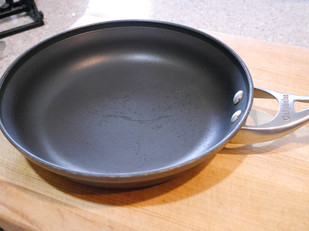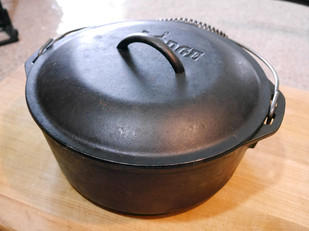
What you’ll need in the way of cookware depends largely on what you use your cookware for and what it is that you plan on cooking most often. Eggs and pancakes, meat and vegetables, stews and stocks? Also consider the cook top you’re using. Gas? Induction? Electric? It makes a difference. Flat-bottomed pans are necessary for a smooth top range, and if you have induction burners, it won’t work with all types of metal. Still a little confused? It’s hard to blame you, so let’s break it down a bit more.
Stainless Steel

Cons: Really the only major drawback is the distribution of heat is questionable unless you’ve got a layer at the bottom of the pan which contains aluminum or copper. That might cost a little more, but is well worth it for a set of cookware that will quite literally last you a lifetime.
Conclusion: This is the best option for everyday cooking, durability (lifetime warranty), and at a reasonable cost. It can handle acidic foods and is easy to clean/maintain. Get the variety with aluminum or copper on the bottom.
Non-Stick

Cons: Yes, the coatings on non-stick are potentially carcinogenic, ESPECIALLY if you try to cook things at a higher temperature (than about 400 Fahrenheit). You cannot put these in the oven like you can with stainless steel, as things tend to melt and the non-stick surface will peel off (which it will do with extensive wear anyhow...notice my non-stick in the picture for an example). You’ll likely have to replace these every 5-10 years, and that’s if you buy the high quality varieties. You cannot use metal utensils,as that will scratch the non-stick surface.
Conclusion: These have their place, but only use it for certain things such as eggs, pancakes, or delicate items such as fish that you’re planning on cooking at medium or lower temperatures. It's recommended to get one of the aluminum versions with the more environmentally friendly (the Teflon ones can actually create fumes that can kill birds) non-stick surface coating.
Cast Iron

Cons: Slightly reactive, heavy, leaches iron (good for most people, but can be bad for people who are trying to avoid more iron in their diet).
Conclusion: Versatile (can use this for cooking anywhere), durable, and once it’s hot it produces an awesome sear. It's nice to have a Dutch oven (like the one in the picture above) around for multiple uses.
Anodized Aluminum
Pros: Great conductivity, lightweight, and very hard.
Cons: Usually has a non-stick coating. Most won’t work on an induction burner and are not dishwasher safe, although they clean up very easily so dishwasher isn’t typically necessary.
Conclusion: It’s basically impossible to find this without non-stick coating these days. Ease of cleaning apparently means more to people than the danger that non-stick fumes can present. But as far as non-sticks go, this is the best.
Copper
Pros: Great conductivity and even cooking.
Cons: It’s expensive, requires regular maintenance and polishing, it can cause grey streaks to form on eggs or other light-colored foods (copper is effectively leaching into your food), and it’s reactive...so acidic foods are likely to take on a metallic taste.
Conclusion: Don’t bother with this unless your sole purpose for it is to make candy. If you own a piece of cookware specifically for that purpose, we’ve probably got other issues we should discuss.
SUMMARY
1. MAIN SET -- Stainless Steel with Aluminum bottom for conductivity – I own this exact set and it’s got a lifetime warranty, is dishwasher safe, has great heat distribution, tempered lids, and it’s easy to clean (I’ll show you a video in a follow-up blog post about maintaining your cookware). The aluminum bottom will run you a few dollars more, but it’ll be worth it.
2. EGGS/PANCAKES/DELICATE FISH – A non-stick pan is what I use for these things, for the most part.
3. ADDITION – I highly recommend having a 5-6 quart Dutch oven for searing meat or for whatever requires some high heat searing action...and because you can transfer it from the grill to the fire to the oven to the stove top and it won’t do a thing to it.
Next time we'll talk about how to care for your cookware. Stainless steel, non-stick, and cast iron will be the focal points of that post.

 RSS Feed
RSS Feed